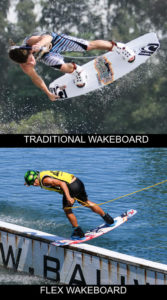Tips by David Ngiam

Board design has come a long way. The best way to choose a board, is to try it out first if possible. Else, here are some tips to choosing the right board that suits your style of riding.
Lots of manufacturers have very different technical terms to describe their boards, the best is to get one of the catalogs and read about it. However, sometimes you have to take their word with a pinch of salt, manufacturers tend to exaggerate the technology that goes into their boards for marketing purposes. Anyway, here are the basics of board design :
LENGTH : Length is usully described in centimeters and is generally used as a basis of determining the right size of board that’s suitable for you, depending on your height and weight. Width is equally important, but generally they are more or less in proportion to length, so don’t worry too much about it. Different board manufactuers have their own charts for determining the right board size for you, and generally you can use that as a good gauge to start with. As a basis though, the larger / heavier you are, the bigger the board you should get. If you get a board that is too small, it will make your landings hard and unforgiving. If you get a board that is too large, it will make it more sluggish in the air, especially for spins
ROCKER : The rocker describes how much the board is curved up on each end. A big rocker (more curved) would make landings more forgiving, but generally makes the board less responsive. A smaller rocker will make the board move fast and generally give a good pop. But it makes landings pretty unforgiving. A board with a progressive rocker has a generally even curve throughout the board. A board with a 3-stage rocker has a flatter sweet spot in the middle of the board and a little more abrupt rocker towards the nose and tail of the board. There are certain advantages in either rocker designs and its really a personal preference.
FINS : Fins can come as detachable fins (removable) or molded fins (part of the board base). Many boat-specific boards now use a combination of both molded fins and regular fins. Generally, smaller fins don’t track as well as larger fins but the release off the wake is better. More advance riders usually opt for smaller fins as they have good edge control and rely less on larger fins to take advantage of the better release off the wake. Large fins may also get in the way when hitting wake park features, such as rails and kickers which is why many wake parks ban the use of fins as it may damage the features. Most cable-specific boards are also designed to be completely finless. In general, for boat, you want to start out with a larger fin to help you track better so that your board doesn’t feel so ‘slippery’. But as you get more comfortable on a wakeboard, you want to reduce the size of your fins and work on improving your edge control instead. For wake parks, since the pull is generally slower and the pull higher, your board tends to sit deeper, so there is less need for a fin to help you track since your board edge would do the same.
FLEX : Traditional wakeboards are generally compression molded and are made stiff, making it more predictable when hitting the wake. Once a board loses it flex (eg, a broken board), it does not retain the potential energy that you have built up on your approach, making it harder to pop off the wake. Cable-specific boards are generally more flexible so that hitting features like rails are more forgiving (for both board and rider) and allows you to ‘press’ more to make the trick look better. Then there are also hybrid boards, which are little bit of both for riders that want to use one board for both boat and cable.
